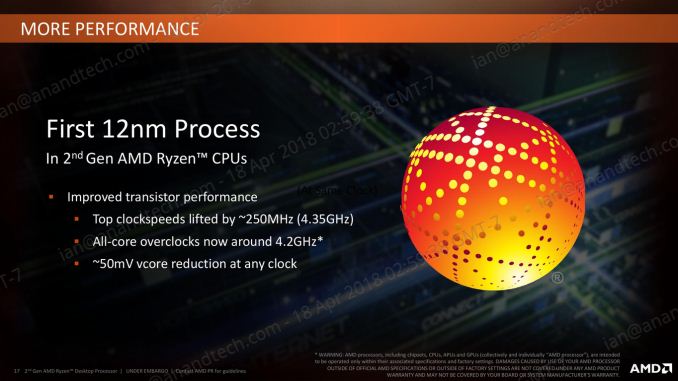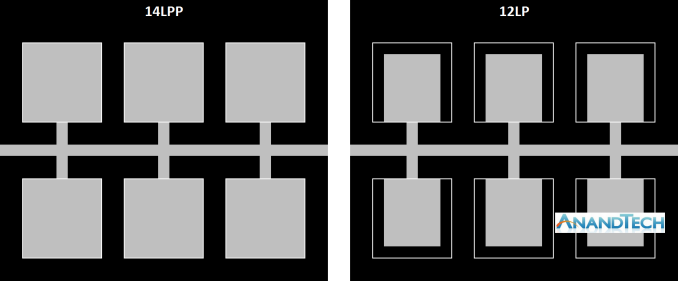The AMD 2nd Gen Ryzen Deep Dive: The 2700X, 2700, 2600X, and 2600 Tested
by Ian Cutress on April 19, 2018 9:00 AM ESTTalking 12nm and Zen+
One of the highlights of the Ryzen 2000-series launch is that these processors use GlobalFoundries’ 12LP manufacturing process, compared to the 14LPP process used for the first generation of Ryzen processors. Both AMD and GlobalFoundries have discussed the differences in the processes, however it is worth understanding that each company has different goals: AMD only needs to promote what helps its products, whereas GlobalFoundries is a semiconductor foundry with many clients and might promote ideal-scenario numbers. Earlier this year we were invited to GlobalFoundries Fab 8 in upstate New York to visit the clean room, and had a chance to interview Dr. Gary Patton, the CTO.
The Future of Silicon: An Exclusive Interview with Dr. Gary Patton, CTO of GlobalFoundries
In that interview, several interesting items came to light. First, that the CTO doesn’t necessarily have to care much about what certain processes are called: their customers know the performance of a given process regardless of the advertised ‘nm’ number based on the development tools given to them. Second, that 12LP is a series of minor tweaks to 14LPP, relating to performance bumps and improvements that come from a partial optical shrink and a slight change in manufacturing rules in the middle-line and back-end of the manufacturing process. In the past this might not have been so news worthy, however GF’s customers want to take advantage of the improved process.
Overall, GlobalFoundries has stated that its 12LP process offers a 10% performance improvement and a 15% circuit density improvement over 14LPP.
This has been interpreted in many ways, such as an extra 10% frequency at the same power, or lower power for the same frequency, and an opportunity to build smaller chips.
As part of today’s launch, AMD has clarified what the move to 12LP has meant for the Ryzen 2000-series:
- Top Clock Speeds lifted by ~250 MHz (~6%)
- All-core overclocks around 4.2 GHz
- ~50 mV core voltage reduction
AMD goes on to explain that at the same frequency, its new Ryzen 2000-series processors draw around 11% less power than the Ryzen 1000-series. The claims also state that this translates to +16% performance at the same power. These claims are a little muddled, as AMD has other new technologies in the 2000-series which will affect performance as well.
One interesting element is that although GF claims that there is a 15% density improvement, AMD is stating that these processors have the same die size and transistor count as the previous generation. Ultimately this seems in opposition to common sense – surely AMD would want to use smaller dies to get more chips per wafer?
Ultimately, the new processors are almost carbon copies of the old ones, both in terms of design and microarchitecture. AMD is calling the design of the cores as ‘Zen+’ to differentiate them to the previous generation ‘Zen’ design, and it mostly comes down to how the microarchitecture features are laid out on the silicon. When discussing with AMD, the best way to explain it is that some of the design of the key features has not moved – they just take up less area, leaving more dark silicon between other features.
Here is a very crude representation of features attached to a data path. On the left is the 14LPP design, and each of the six features has a specific size and connects to the bus. Between each of the features is the dark silicon – unused silicon that is either seen as useless, or can be used as a thermal buffer between high-energy parts. On the right is the representation of the 12LP design – each of the features have been reduced in size, putting more dark silicon between themselves (the white boxes show the original size of the feature). In this context, the number of transistors is the same, and the die size is the same. But if anything in the design was thermally limited by the close proximity of two features, there is now more distance between them such that they should interfere with each other less.
For reference, AMD lists the die-size of these new parts as 213mm2, containing 4.8 billion transistors, identical to the first generation silicon design. AMD confirmed that they are using 9T transistor libraries, also the same as the previous generation, although GlobalFoundries offers a 7.5T design as well.
So is Zen+ a New Microarchitecture, or Process Node Change?
Ultimately, nothing about most of the Zen+ physical design layout is new. Aside from the manufacturing process node change and likely minor adjustments, the rest of the adjustments are in firmware and support:
- Cache latency adjustments leading to +3% IPC
- Increased DRAM Frequency Support to DDR4-2933
- Better voltage/frequency curves, leading to +10% performance overall
- Better Boost Performance with Precision Boost 2
- Better Thermal Response with XFR2













545 Comments
View All Comments
John_M - Monday, April 23, 2018 - link
What edition of Windows 10 to typical gamers use and why?johnsmith222 - Monday, April 23, 2018 - link
In the meantime we have a lot benches to analyse :)Sum of web benches:
https://www.3dcenter.org/news/ryzen-2000-launchrev...
oRAirwolf - Monday, April 23, 2018 - link
I would really like to see some storage bench mark to compare pre and post Spectre/Meltdown patching of Intel CPUs as well as an apples-to-apples comparison of nvme storage performance compared to an Intel 8700k.Silma - Monday, April 23, 2018 - link
It's really hard to generalize on why people purchase the processors they do.I met a guy online with an over the top, super expensive computer. His sole purpose seems to be the first in the online tests and he will spend hours fine tuning the overclocking and whatnot.
Another guy mostly playing D3 purchased a 3K euro computer, which is absolutely over the top for what he plays/does. His reasoning is, I change my computer every 10 years, so when i do, I want the best components.
In my opinion, for most people without special needs (YouTube encoding, 3D rendering and whatnot), most processors have been good enough for years, and there is no reason to invest a lot in a processor when money is much better spent in an x4 PCIe SSD where you'll instantly feel the difference vs a hard drive or a medium quality SSD.
To me, power consumption and noise of processor as well as graphic card is a consideration at least as important as price.
The sole reason I would change processor today would be to get a fully Thunderbolt 3 compatible system, since the first TB3 audio interfaces are slowly coming to market.
Then again, I'm sure many people will have other priorities and reasons for purchasing their processors.
Targon - Monday, April 23, 2018 - link
Many of these high end systems are overpriced, or they come with components that are not worth it for what is being done. With that being said, going for a higher end CPU does make sense for those looking to keep their systems for a long time. Video cards and storage are areas that people should pay close attention to when it comes to price.NVMe drives are VERY expensive if you go up to the 1TB level, so spending that sort of money doesn't make sense when the prices will drop in the next two years. A 250-500GB NVMe drive would make more sense when combined with a traditional hard drive for additional storage. Video cards are also at a premium right now, as is RAM. If the system were purchased back in April of 2017, then yea, not too horrible to go for 32GB of RAM back then, but now, I'd stick with 16GB of RAM due to the prices being so much higher than they were.
For desktops, Thunderbolt isn't all that amazing when you can add a video or sound card to the system that will do what you want it to. Laptops are another story, and you need to pick and choose your priorities.
Flying Aardvark - Monday, April 23, 2018 - link
That's if you're short on money. I don't spend much extra other than vacations & eating very well. So when I upgrade, which is every 5 to 10 years, I buy the best available like Silma. I have a 1TB 960 Pro for that reason, it was $650 and I didn't think twice about it. I need the most reliable, fastest drive at the time. The 960 Pro is a MLC memory configuration, I've always used higher end MLC drives and they've served me very well.I'm not waiting a year or two, when I have over $100,000 sitting in my bank account doing nothing. What's the point, it's just $650. Same goes for the rest of my computer, which I only own/maintain one of.
Not everyone is a child or someone who doesn't spend the majority of their time progressing their careers so they can make more money. The price consideration is not the end-all, ultimate rule on hardware for every single consumer.
mapesdhs - Monday, April 23, 2018 - link
Indeed, though I guarantee some here will react poorly at the notion of someone who can make such a purchasing decision. :) Sometimes the best makes perfect sense, and if one can afford it, then why not.Kaihekoa - Monday, April 23, 2018 - link
Why are Anand's gaming numbers showing the 2700X beating all Intel CPUs when every other reviewer still shows the 8700K/7700K still being the best gaming CPUs?Flying Aardvark - Monday, April 23, 2018 - link
TechRadar & the wccftech preview has the same results. If you have been following Spectre as I have, you would've seen even users find this result. See the top comments here. https://np.reddit.com/r/pcmasterrace/comments/7obo...AT, TR & WCCF's results are accurate. Many reasons for this.
- Many reviewers used the old Ryzen balanced power setting which cripples the 2700X
- Disallowed the motherboard settings that push the chip over TDP
- Fully patched as possible for Spectre v1 & v2, which cripples Intel up to 50% in IO heavy tasks (streaming textures for games that do so).
There is naturally, lots of resistance to the fact that AMD is dominating. It's over for now, time for people to just admit it, they got screwed if they don't have Ryzen. Or at least, bought the inferior product.
mapesdhs - Monday, April 23, 2018 - link
I don't think those posting so much venom about the results will change their minds until AMD releases something that really is just right out the gate blatantly faster, including for IPC. Another year or two and I think that will happen.